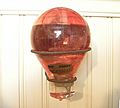Carbon tetrachloride facts for kids
Quick facts for kids Carbon tetrachloride |
|
|---|---|
 |
|
| IUPAC name | Carbon tetrachloride, Tetrachloromethane |
| Other names | Benziform, Benzinoform, Carbon chloride, Carbon tet, Freon-10, Refrigerant-10, Halon-104, Methane tetrachloride, Methyl tetrachloride, Perchloromethane, Tetraform, Tetrasol |
| Identifiers | |
| CAS number | |
| PubChem | |
| EC number | 200-262-8 |
| KEGG | C07561 |
| ChEBI | CHEBI:27385 |
| RTECS number | FG4900000 |
| SMILES | ClC(Cl)(Cl)Cl |
|
InChI
InChI=1/CCl4/c2-1(3,4)5
|
|
| Properties | |
| Molecular formula | |
| Molar mass | 0 g mol-1 |
| Appearance | colourless liquid |
| Odor | Sweet, ether-like odor |
| Density | 1.5867 g cm−3 (liquid) 1.831 g cm−3 at −186 °C (solid) |
| Melting point | |
| Boiling point | |
| 0.097 g/100 mL (0 °C) 0.081 g/100 mL (25 °C) |
|
| Solubility | soluble in alcohol, ether, chloroform, benzene, naphtha, CS2, formic acid |
| log P | 2.64 |
| Vapor pressure | 11.94 kPa at 20 °C |
| kH | 2.76x10−2 atm-cu m/mol |
| -66.60·10−6 cm3/mol | |
| Refractive index (nD) | 1.4607 |
| Dipole moment | 0 D |
| Structure | |
| Crystal structure | Monoclinic |
| Coordination geometry |
Tetragonal |
| Molecular shape | Tetrahedral |
| Dipole moment | 0 D |
| Thermochemistry | |
| Std enthalpy of formation ΔfH |
-139.3 kJ/mol |
| Standard molar entropy S |
214.42 J/mol K |
| Specific heat capacity, C | 132.6 J/mol K |
| Hazards | |
| EU classification | |
| NFPA 704 |
|
| R-phrases | R23/24/25, R40, R48/23, R59, R52/53 |
| S-phrases | (S1/2), S23, S36/37, S45, S59, S61 |
| Flash point | <982°C |
| U.S. Permissible exposure limit (PEL) |
TWA 10 ppm C 25 ppm 200 ppm (5-minute maximum peak in any 4 hours) |
| Related compounds | |
| Other cations | Silicon tetrachloride Germanium tetrachloride Tin tetrachloride Lead tetrachloride |
| Except where noted otherwise, data are given for materials in their standard state (at 25 °C, 100 kPa) | |
Carbon tetrachloride, also known as carbon tet or Freon 10, is a chemical compound. Its chemical formula is CCl4. It contains carbon in its +4 oxidation state and chloride ions.
Properties
It is a colorless liquid. It smells like ether. It evaporates quite quickly. It can dissolve fats and oils as well as other stuff such as iodine. It doesn't burn, but it does make phosgene when heated to a high temperature.
Preparation
It is made by reacting methane with chlorine. This reaction is similar to the burning of methane (reaction of methane with oxygen). Hydrogen chloride is a byproduct (left over substance). It used to be made by reacting carbon disulfide with chlorine. This reaction would produce sulfur(I) chloride.
Uses
The uses of carbon tetrachloride have diminished lately because it is known to be damage people's health. People think it might damage the ozone layer. Today, it is rarely used for anything.
Previously, was used in fire extinguishers. It was also used to make freon, used in dry cleaning and as a refrigerant.
Safety
Carbon tetrachloride is very poisonous to the liver, the kidneys and the nervous system; it might also cause cancer.
Related pages
Images for kids
See also
 In Spanish: Cloruro de carbono(IV) para niños
In Spanish: Cloruro de carbono(IV) para niños






